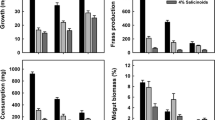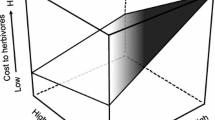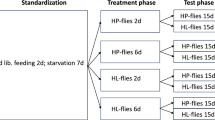Summary
Like many polyphagous herbivores, individuals of Sarasinula plebeia (Fischer) (Soleolifera: Veronicellidae) consume a variety of plant species that may differ in nutritional content. In this study we determined the ability of these slugs to compensate for such variation in diet composition. Dilution with water of an agar-based diet containing commercial guinea pig food or carrot root to obtain dry weights (dw) of 90, 70, 40 and 10% of diet fresh weight (fw), caused immature slugs to consume increasingly more fresh weight of food [as much as 4.7-(guinea pig) to 6.1-fold (carrot) more]. Dry weight consumption and body mass-relative dry weight consumption rate also increased at intermediate dilutions, buth with further dilution, dry weight intake declined despite the greater fresh weight consumption. At each dilution level, slugs fed the guinea pig diet consumed from ca. 5-to 6.4-fold more fresh weight than the carrotfed slugs. The former grew substantially, with their final biomass and body mass-relative growth rate varying curvilinearly with diet % dw. If these slugs had not fed more but instead maintained the same fresh weight consumption as slugs in the 90% dw tretments, without altering food utilization efficiencies, then their biomass gain in the 70, 40 and 10% dw treatments would have been only about 62, 43, and 21%, respectively, of the values actually attained. In contrast, carrot-fed slugs did not grow and were only able to maintain their initial biomass. For each diet, slug tissue water (% fw) was highest in the most diluted treatment but did not differ significantly among the other dilution levels. Approximate digestibility of the carrot diet was highest at intermediate dilution levels (ca. 75% of ingested food was digested and absorbed); for the guinea pig diet, this efficiency declined linearly from about 66% to 59% with increased dilution. For slugs that grew (i.e., those fed the guinea pig diet), effeciences of converting digested (29–52%) and ingested (18–33%) food to dry biomass were both curvilinearly related to diet % dw. Thus, S. plebeia, like many other herbivores, has the capacity to increase food consumption substantially inresponse to reduced dietary nutrient level, allowing the slugs to cope with variable nutrient content in their food plants.
Similar content being viewed by others
References
Andrews KL (1989) Slug pests of dry beans in Central America. In: Slugs and snails in world agriculture. British Crop Protection Council Mongraph No. 41. Thorton Health, UK, pp 85–89
Andrews KL, Valverde VH, Ramirez O (1985) Preferencia alimenticia de la babosa, Sarasinula plebeia (Fischer). Ceiba 26:59–65
Bailey SER, Cordon S, Hutchinson S (1989) Why don't slugs eat more bait? A behavioural study of early meal termination produced by methiocarb and metaldehyde baits in Deroceras caruanae. In: Slugs and snails in world agriculture. British Crop Protection Council Monograph No. 41. Thorton Heath, UK, pp 385–390
Calow P (1975) The feeding strategies of two freshwater gastropods, Ancylus fluviatilis Mull. and Planorbis contortus Linn. (Pulmonata), in terms of ingestion rates and absorption efficiencies. Oecologia 20:33–49
Calow P (1982) Homeostasis and fitness. Am Nat 120:416–419
Cates RG (1975) The interface between slugs and wild ginger: Some evolutionary aspects. Ecology 56:391–400
Cates RG, Orians GH (1975) Successional status and the palatability of plants to generalized herbivores. Ecology 56:410–418
Cook A (1987) Functional aspects of the mucous-producing glands of the Systellommatophoran slug, Veronicella floridana. J Zool 211:291–305
Cook A, Radford DJ (1988) The comparative ecology of four sympatric limacid slug species in northern Ireland. Malacologia 28:131–146
Davidson DH (1976) Assimilation efficiencies of slugs on different food materials. Oecologia 26:267–273
Dirzo R (1980) Experimental studies on slug-plant interactions. I. The acceptability of thirty plant species to the slug Agriolimax caruanae. J Ecol 68:981–998
Gelperin A (1975) Rapid food-aversion learning by a terrestrial mollusk. Science 189:567–570
Gordon HT (1972) Interpretation of insect quantitative nutrition. In: Rodriguez JG (ed) Insect and mite nutrition: significance and implications in ecology and pest management. Elsevier, Amsterdam, pp 73–105
Grime JP, MacPherson-Stewart F, Dearman RS (1968) An investigation of leaf palatability using the snail Cepaea nemoralis L. J Ecol 56:405–420
Guerin PM, Ryan MF (1980) Insecticidal effect of trans-2-nonenal, a constituent of carrot root. Experientia 36:1387–1388
Horne FR (1977) Regulation of urea biosynthesis in the slug, Limax flavus Linné. Comp Biochem Physiol 56B:63–69
Lawrey JD (1983) Lichen herbivore prefence: A test of two hypotheses. Am J Bot 70:1188–1194
Lyth M (1982) Water-content of slugs (Gastropoda: Pulmonata) maintained in standardized culture conditions. J Mollus Stud 48:214–218
Machin J (1975) Water relationships. In: Fretter V, Peake J (eds) Pulmonates, vol. 1. Academic, London, pp 105–163
Maki A, Kitajima J, Abe F, Stewart G, Ryan MF (1989) Isolation, identification, and bioassay of chemicals affecting nonpreference carrot-root resistance to carrot-fly larva. J Chem Ecol 15:1883–1897
McGinnis AJ, Kasting R (1967) Dietary cellulose: Effect on food consumption and growth of a grasshopper. Can J Zool 45:65–67
Mills JD, Bailey SER, McCrohan CR (1989) Effects of molluscicides on feeding behaviour and neuronal activity. In: Slugs and snails in world agriculture. British Crop Protection Council Monography No. 41. Thorton Heath, UK, pp 77–83
Molgaard P (1986) Food plant preferences by slugs and snails: A simple method to evaluate the relative palatability of the food plants. Biochem Syst Ecol 14:113–121
Montgomery DC (1984) Design and analysis of experiments. 2nd ed. Wiley, New York
Prior DJ (1989) Contact-rehydration in slugs: A water regulatory behaviour. In: Slugs and snails in world agriculture British Crop Protection Council Monographs No. 41. Thorton Health, UK, pp 217–223
Ratheke B (1985) Slugs as generalist herbivores: Tests of three hypotheses on plant choices. Ecology 66:828–836
Reingold SC, Gelperin A (1980) Feeding motor programme in Limax. II. Modulation of sensory inputs in intact animals and isolated central nervous systems. J Exper Biol 85:1–19
Richardson AMM (1975) Food, feeding rates and assimilation in the land snail Cepaea nemoralis L. Oecologia 19:59–70
Rollo CD (1984) Resource allocation and time budgeting in adults of the cockroach, Periplaneta americana: The interaction of behaviour and metabolic reserves. Res Pop Ecol 26:150–187
Rollo CD (1988a) A quantitative analysis of food consumption for the terrestrial Mollusca Allometry, food hydration and temperature. Malacologia 28:41–51
Rollo CD (1988b) The feeding of terrestrial slugs in relation to food characteristics, starvation, maturation and life history. Malacologia 28:29–39
Rollo CD, Hawryluk MD (1988) Compensatory scope and resource allocation in two species of aquatic snails. Ecology 69:146–156
Rueda A (1989) Artificial diet for laboratory maintenance of the veronicellid slug Sarasinula plebeia (Fischer). In: Slugs and snails in world agriculture. British Crop Protection Council Monograph No. 41. Thorton Heath, UK, pp 361–366
Runham NW (1975) Alimentary canal. In: Fretter V, Peake J, (eds) Pulmonates, vol. 1. Academic, London, pp 53–104
Runham NW, Hunter PJ (1970) Terrestrial slugs. Hutchinson University Library, London
SAS Institute, Inc (1987) SAS proprietary software release 6.03 SAS Institute, Cary, North Carolina
Schmidt-Nielsen K, Taylor CR, Shkolnik A (1971) Desert snails: Problems of heat, water and food. J Exper Biol 55:385–398
Senseman DM (1978) Short-term control of food intake by the terrestrial slug Ariolimax. J Comp Physiol 124:37–48
Simpson SJ, Simpson CL (1990) The mechanisms of nutritional compensation by phytophagous insects. In: Bernays EA (ed) Insect/plant interactions, vol II. CRC, Orlando, FL, pp 111–160
Slansky F Jr (1991) Nutritional ecology: The fundamental quest for nutrients. In: Stamp NE, Casey TM (eds) Ecological and evolutionary constraints on foraging of caterpillars. Chapman & Hall, New York (in press)
Slansky F Jr, Scriber JM (1985) Food consumption and utilization. In: Kerkut GA, Gilbert LI (eds) Comprehensive insect physiology, biochemistry and pharmacology, vol. 4 Pergamon, Oxford, pp 87–163
Stern G (1969) Bilan énergétique de la limace Arion rufus en période de croissance. C R Acad Sci (Paris) 269:1015–1018
Susswein AJ, Kupfermann I (1975a) Bulk as a stimulus for satiation in Aplysia. Behav Biol 13:203–209
Susswein AJ, Kupfermann I (1975b) Localizations of bulk stimuli underlying satiation in Aplysia. J Comp Physiol 101:309–328
Waite TA (1987) Behavioral control of water loss in the terrestrial slug Deroceras reticulatum (Muller): Body-size constraints. Veliger 30:134–137
Waldbauer GP (1968) The consumption and utilization of food by insects. Adv Insect Physiol 5:229–288
Zar JM (1984) Biostatistical analysis. 2nd ed. Prentice Hall, Englewood Cliffs, NJ
Author information
Authors and Affiliations
Rights and permissions
About this article
Cite this article
Rueda, A.A., Slansky, F. & Wheeler, G.S. Compensatory feeding response of the slug Sarasinula plebeia to dietary dilution. Oecologia 88, 181–188 (1991). https://doi.org/10.1007/BF00320809
Received:
Accepted:
Issue Date:
DOI: https://doi.org/10.1007/BF00320809




